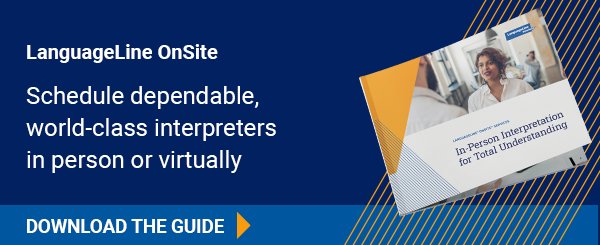
Just like any other aspect of an important meeting, working with an onsite interpreter requires preparation and an eye for some key details.
Here are some things you can do before, during, and after your meeting to make sure you communicate successfully.
Before the Meeting
Talk with Your Interpreter
This might seem obvious, but if you’ve never worked with an interpreter before, you may not know what to discuss. Here are a few guidelines for that first conversation:
- Determine consecutive or simultaneous. Make sure you understand the difference between consecutive interpretation and simultaneous interpretation and consider which will be most appropriate for your meeting. In consecutive interpretation, the interpreter waits for the speaker to finish a sentence or an idea, and then renders the speaker's words into the target language. In simultaneous interpretation, the participants wear headphones, and the interpreter renders the speaker's words into the target language as he or she is speaking.
- Give your interpreter an overview of the topic. The interpreter should know important terminology and ideas, as well as key participants who will be present.
- Review logistics. You should have enough familiarity with the setting to ensure an appropriate place is available for the interpreter to sit or stand and be sure you have the right technology in place.
Provide Any Written Materials in Advance
Give your interpreter any written remarks, notes, or presentation materials ahead of time so they can familiarize themselves with the topic and look up any terminology they may not already know. Confidentiality clauses are standard in interpretation contracts, so you can trust a business interpreter to protect your company’s information.
Keep Time in Mind
Consecutive interpretation will probably be appropriate for most meetings. That means one person says a few sentences, then pauses while the interpreter converts the speech into the other language. This doubles the length of any interaction.
Also, keep in mind that interpreting is mentally demanding, so you may need more than one interpreter for a lengthy meeting or visit so they can work as a team, switching off as needed.
During the Meeting
Don’t Address the Interpreter
Make eye contact with your audience and speak directly to them, not your interpreter. The whole reason you’re in the room with your patient or client is to build trust, reduce misunderstandings, and improve customer or patient experience at the moment of need. An interpreter isn’t part of the conversation; they just help to facilitate it.
Watch What You Say
It’s an interpreter’s job to interpret everything that’s said, so keep side chatter to a minimum and don’t say anything you don’t want your interpreter to repeat.
Speak slowly and clearly, pausing frequently so the interpreter can recall and convey everything you’ve said.
Try to avoid complex sentence structures, changing topics mid-sentence, humor, or using figures of speech. (Most native English speakers are used to hearing about the 800-pound gorilla in the room, but your audience may not be!)
After the Meeting
Acknowledge and Follow Up
Although an interpreter doesn’t play the role of a participant in a meeting, the meeting couldn’t happen without them. Take a moment at the end to acknowledge and thank your interpreter’s hard work. If you’ll need their services again, make sure to touch base afterward to talk about what went well and what could be handled better next time.
About LanguageLine®
LanguageLine has been the world leader in innovative language-access solutions since 1982. The company sets the global standard for phone, video, and onsite interpreting, as well as translation of the written word. LanguageLine is trusted by more than 30,000 clients to enable communication with the limited English proficient, Deaf, and Hard of Hearing communities. LanguageLine provides the industry’s fastest and most dependable access to more than 35,000 professional linguists in 290-plus languages — 24 hours a day, seven days a week, 365 days a year. Please do not hesitate to contact us.

